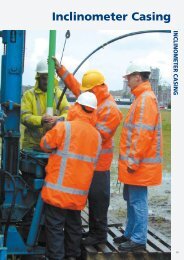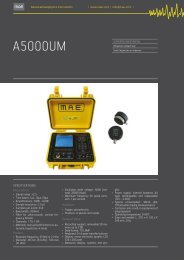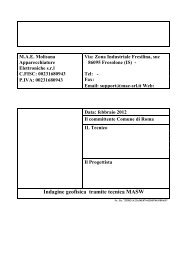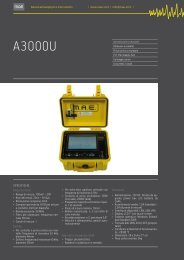Untitled
Untitled
Untitled
You also want an ePaper? Increase the reach of your titles
YUMPU automatically turns print PDFs into web optimized ePapers that Google loves.
› Mae 27<br />
› PASSIVE SEISMIC – EXPLORATION FOR THE EVALUATION OF THE<br />
LOCAL SEISMIC RESPONSE – MICRO EARTHQUAKES<br />
This technique is used to obtain information<br />
concerning possible dynamic from the convolution of the frequen-<br />
the study of the spectrums obtained<br />
amplification effects of seismic waves cy of the signal recorded in the domain<br />
for the three components of the<br />
in “ emersion ”. It is based on the recording<br />
of the background noise in ground motion and the application<br />
the time domain and following elaboration<br />
of the signal’s frequencies in (H/V), allows to define and measure<br />
of techniques on spectrum analysis<br />
the domain. It is carried out by placing<br />
a tridimensional geophone on the and the seismic frequency of the<br />
possible local seismic amplifications<br />
ground with low frequency response site. The measurements of the microearthquake<br />
can also be taken in linear<br />
and by recording the seismic noise in<br />
different temporal windows. Later on, “arrays” for the localization of faults.<br />
› NAKAMURA METHOD<br />
A significant part of the damages observed<br />
in destructive earthquakes all<br />
over the world is associated with the<br />
amplification of seismic waves due to<br />
the effects of the local site. The analysis<br />
of the site response is therefore essential<br />
in the evaluation of the seismic<br />
risk in areas subject to earthquakes.<br />
In order to evaluate the effects of the<br />
local site, a series of surveys must be<br />
carried out. Among the empiric methods,<br />
the method of spectrum analyses<br />
H/V on environmental vibrations is<br />
one of the most common. The method,<br />
also called “Nakamura” technique<br />
(Nakamura, 1989), was introduced by<br />
Nogoshi and Igarashi (1971) based on<br />
the initial studies of Kanai and Tanaka<br />
(1961). Since then, many researchers<br />
worldwide performed a large number<br />
of applications.<br />
An important requirement to carry out<br />
the H/ V method consists in a fairly good<br />
knowledge of seismology combined<br />
with basic information on local geological<br />
conditions supported by geo-physical<br />
and geo-technical data. The method<br />
is generally applied in micro-zoning<br />
studies and in the analysis of the local<br />
response of specific sites.<br />
› SEISMIC MONITORING<br />
Seismic monitoring is carried out in areas<br />
subject to risks related to a seismogenic<br />
activity, by acquiring the<br />
seisms with time and recording the<br />
seismograms. Seismic stations are<br />
used able to record in threshold or<br />
continuous type, and low frequency<br />
geophones or seismic accelerometers.<br />
The recording in the long period,<br />
of the earthquakes relative to a<br />
site or fairly large area allows to configure<br />
the seismic scenario of an area<br />
and evaluate the risk and vulnerability<br />
conditions. If the monitoring activity<br />
is supported by specific knowledge<br />
of geological and geo-technical<br />
type, we are talking about seismic Micro-zoning.









